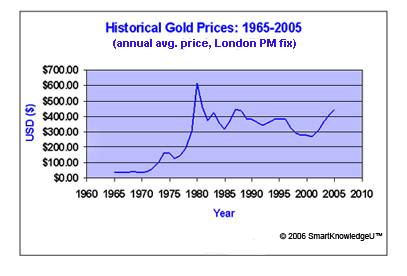October 1, 2006 –
 The recent sharp decline in gold has shaken a lot of gold bulls out of the market with many people exiting and cutting their losses. And as steep, quick and brutal as this last correction has been, we may still be in a consolidation phase where gold may dip even lower before starting its next leg higher. But that leg higher I’m convinced will start very soon. Without getting into all the minute details of everything I research to make my decisions, let’s just say my calls on the price of gold for the past five months, if you go back and check my newsletters and prior blog entries, have been almost dead on. This is because I dig way down deep into the rabbit hole and consider many non-standard economic factors to formulate my predictions.
The recent sharp decline in gold has shaken a lot of gold bulls out of the market with many people exiting and cutting their losses. And as steep, quick and brutal as this last correction has been, we may still be in a consolidation phase where gold may dip even lower before starting its next leg higher. But that leg higher I’m convinced will start very soon. Without getting into all the minute details of everything I research to make my decisions, let’s just say my calls on the price of gold for the past five months, if you go back and check my newsletters and prior blog entries, have been almost dead on. This is because I dig way down deep into the rabbit hole and consider many non-standard economic factors to formulate my predictions.
Many of the factors I consider, according to the analyses I read of major investment firms, are just flat out ignored by their chief global economists. I strongly consider this recent steep correction in gold prices as a stellar opportunity to buy, not to liquidate, current positions in gold stocks. I wrote in a prior blog entry that when everyone is staying out and afraid, the best investors must be courageous and bold. Not rash. But courageous in light of careful, insightful research that contradicts the overwhelming sentiment at the time. And people are overwhelmingly afraid of gold right now.
So let’s review a very condensed timeline of gold’s price behavior.
THE GOLD TIMELINE
560-546 B.C. – King Croesus of what is now modern-day Turkey issues the first wide scale lots of gold coins used for money and commerce.
1879 — the U.S. Government issues currency during the Civil War that is redeemable in gold.
1900 – the U.S. Government passes legislation that officially places U.S. currency on a gold standard.
1914 — Many countries around the world also adopt the gold standard for their currency.
1933 — U.S. President Franklin Roosevelt bans all U.S. citizens’ from buying, selling, or owning gold though the U.S. government continues to trade gold. The price of gold skyrockets by 65% as a result of this ban.
1971– U.S. President Richard Nixon takes the world off the gold standard. The world goes on the “petrodollar” standard as the U.S. negotiates with OPEC for all oil to be sold only in U.S. dollars.
1980– Gold reaches a peak of about $850 an ounce amid geopolitical instability introduced by Russia’s invasion of Afghanistan and the Shi’ite revolution in Iran and the start of the Iran-Iraq war.
1988 — the U.S. movie Die Hard with Bruce Willis is released, showing huge military truckloads of gold being stolen from Fort Knox, skewing the beliefs of people everywhere about how much gold in the world actually exists. Actually, all the gold in the world ever mined up to today’s date in 2006 would only form a solid cube slightly larger than 22 meters in length by my calculations (using publicly printed statistics).
1990- 1997 — India introduces multiple laws over these 7 years that deregulate its gold market, making it easier for people to buy and sell gold.
1992 -2002 — Recession fears and fears of a banking system collapse spur the Japanese to become the second largest hoarders of gold behind only India, making the Japanese and the Indians some of the most well-positioned individuals and institutions in the world today to benefit from a continuing gold bull run.
1994 – Only slightly more than 40 million ozs. of total global gold production is forward sold this year and gold trades at almost $400 an oz.
1994 —1996 – the amount of gold that is forward sold rises almost 150% to 100 million ozs, and the price of gold plunges by a whopping $275 an ounce.
1999 — the Central Bank Gold Agreement (also known as the Washington Agreement on Gold), an agreement among a consortium of 15 European central banks, is drafted. The agreement stipulates that:
1. Gold will remain an important element of global monetary reserves.
2. Gold sales already decided and to be decided by the undersigned institutions will be achieved through a concerted program of sales over a period of five years, starting on 27 September 2004, just after the end of the previous agreement. Annual sales will not exceed 500 tons and total sales over this period will not exceed 2,500 tons.
3. Over this period, the signatories to this agreement have agreed that the total amount of their gold leasings and the total amount of their use of gold futures and options will not exceed the amounts prevailing at the date of the signature of the previous agreement.
4. This agreement will be reviewed after five years.
1999 (May) — Gordon Brown announces that the Bank of England will sell more than 415 tonnes of gold, about half of their entire gold reserves. Sales will start in 2000 and end a more than 300-year old Bank of England tradition of maintaining a significant percentage of their reserves in gold. The sales announcement and actual sales help keep the price of gold depressed for the next several years.
2001 — Gold reaches a 21-year of low of about $250 an ounce.
2000 – 2005 – Hedged gold positions decrease from about 100 million ounces to less than 60 million ozs. The price of gold skyrockets from $275 an ounce to over $500 an ounce.
2004 – the Washington Agreement is renewed for five additional years until 2009
2006 (March) — Italy dumps billions of dollars from its reserves, decreasing their dollar reserves from 84% to 63%, replacing it with pounds sterling. Russia, the fourth largest central bank in the world, slashes dollar reserves from about 67% to 40%.
2006 (April) — Switzerland dumps dollars, decreasing their dollar reserves from 37% to 20%.
2006 (July) — the United Arab Emirates states that they will convert up to 10% of their currency reserves into gold, but states that the price of gold “is too expensive” and will exchange it when the price of gold is more reasonable. The actions of the central banks of Italy, Switzerland, and the UAE are important because of the inverse relationship between the value of the dollar and gold. Also as people lose faith in paper currency, the value of gold increases.
2006 (August, September) — Gold deviates from its normal historical price behavior, with these months traditionally strong months in the performance of the price of gold. But remember the statements above. The UAE is not the only central bank that desires to add enormous positions of gold to their reserves. A significantly lower price obviously would save them hundreds of millions of dollars, and collectively among all central banks desirous of adding gold positions, most probably, billions of dollars.
2006 (August) — European central banks announce that they expect to only sell 75% of the quotas set forth by the Washington Agreement.
2006 (September) — China and Japan still hold massive amounts of U.S. Treasury bonds in their holdings. China alone has about USD $1 trillion. It is well known that both Japan and China are highly concerned about the enormous amounts of U.S. dollars they hold in their reserves.
2006 (September) — the price of gold steeply plunges on rumors that European central banks are selling large amounts of gold, but no selling has since been confirmed.

2006 (September) — Gold is nowhere near it’s peak 1980 price of roughly $850 an ounce if we adjust this price for inflation. In that case, in inflation-adjusted dollars, the peak price of gold in 1980 would be over $2,000 an ounce. Either way, gold experienced a 22-year bear market from 1980 — 2001. Currently we’ve only been in a 6-year bull market to counteract that 22-year bear market.
Review of the Gold Timeline –
Last month, James Quinn, a commodity commentator for AG Edwards, makes a comment that sums up the non-committal, wait-and-see approach of many analysts: “There’s been talk circulating about central bank gold sales. I see it as a double-edged sword. If you are bullish, you say they are holding back because the [central banks] don’t want to sell the gold. If you are bearish, you’re saying they’ll eventually sell gold because they can.” (MSN News, August 20,2006).
The only problem with this approach is by the time the bull run gets going again and many people jump on-board, many gains will have been missed. Just as gold historically corrects very steeply in price, it also has a history of bounding higher very steeply as well. Again, I strongly consider this recent steep correction in gold prices as a stellar opportunity to buy, not to liquidate, or to get on board with gold stocks.
Coming soon, after the launch of our comprehensive maalamalama site, I will provide a much more comprehensive case for gold over the next several years.